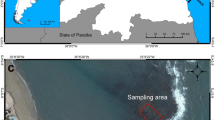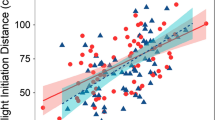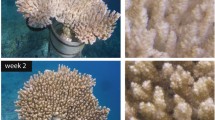Abstract
Herbivorous damselfish that cultivate algal farms frequently exhibit aggressive territorial behaviour to defend their investment from intruders, particularly against other herbivorous fish and invertebrates. On a coastal coral reef in New Caledonia, the response of the damselfish Hemiglyphidodon plagiometopon to intruders of varying type and level of threat to their algal farm was tested. Responses to live and dead coral fragments, carnivorous whelks, shells, and rocks varied from no response to biting and extrusion from farms. Damselfish elicited the strongest defensive response to the herbivorous sea urchin Echinometra mathaei, rapidly attacking the urchin by biting and lifting it from farms, before extruding it up to 3.5 m away. H. plagiometopon responded in a similar manner to dead urchins (no threat of herbivory) as to live urchins, but typically did not extrude them as far. Ultimately, damselfish responded to intruders in a manner largely consistent with the level of threat posed to their algal farm, with the similar response between live and dead urchins suggesting such strong defensive behaviours may be combination of ‘hard-wired’ and learned behaviours in reaction to the level of realised threat.




Similar content being viewed by others
References
Ceccarelli DM (2007) Modification of benthic communities by territorial damselfishes: a multi-species comparison. Coral Reefs 26:853–866
Ceccarelli DM, Jones GP, McCook LJ (2001) Territorial damselfishes as determinants of the structure of benthic communities on coral reefs. Oceanogr Mar Biol Annu Rev 39:355–389
Chapman ARO, Johnson CR (1990) Disturbance and organization of macroalgal assemblages in the Northwest Atlantic. Hydrobiologia 192:77–121
Dee LE, Witman JD, Brandt M (2012) Refugia and top-down control of the pencil urchin Eucidaris galapagensis in the Galapagos marine reserve. J Exp Mar Biol Ecol 416-417:135–143
Eurich JG, McCormick MI, Jones GP (2018) Habitat selection and aggressio as determinants of fine-scale partitioning of coral reef zones in a guild of territorial damselfishes. Mar Ecol Prog Ser 587:201–215
Ferreira CEL, Goncalves JEA, Coutinho R, Peret AC (1998) Herbivory by the dusky damselfish Stegastes fuscus (Cuvier, 1830) in a tropical rocky shore: effects on the benthic community. J Exp Mar Biol Ecol 229:241–264
Frederich B, Parmentier E (2016) Biology of damselfishes. CRC Press, Boca Raton
Glynn PW, Colgan MW (1988) Defense of corals and enhancement of coral diversity by territorial damselfishes. Proceedings of the 6th international coral reef symposium 2:157-163
Hata H, Ceccarelli DM (2016) Farming behaviour of territorial damselfishes. In: Frederich B, Parmentier E (eds) Biology of damselfishes. CRC Press, Boca Raton, pp 122–152
Hata H, Kato M (2002) Weeding by the herbivorous damselfish Stegastes nigricans in nearly monocultural algae farms. Mar Ecol Prog Ser 237:227–231
Hata H, Umezawa Y (2011) Food habits of the farmer damselfish Stegastes nigricans inferred by stomach content, stable isotope, and fatty acid composition analyses. Ecol Res 26:809–818
Hattori A, Shibuno T (2013) Habitat use and coexistence of three territorial herbivorous damselfish on different-size patch reefs. J Mar Biol Ass UK 93:2265–2272
Hourigan TF (1986) An experimental removal of a territorial pomacentrid: effects on the occurrence and behavior of competitors. Environ Biol Fish 15:161–169
Irving AD, Witman JD (2009) Positive effects of damselfish override negative effects of urchins to prevent an algal habitat switch. J Ecol 97:337–347
Jackson JBC (2001) What was natural in the coastal oceans? Proc Natl Acad Sci U S A 98:5411–5418
Jan RQ, Ho CT, Shiah FK (2003) Determinants of territory size of the dusky Gregory. J Fish Biol 63:1589–1597
Kamath A et al (2019) Potential feedback between coral presence and farmerfish collective behavior promotes coral recovery. Oikos 128:482–492
Lassuy DR (1980) Effects of "farming" behavior by Eupomacentrus lividus and Hemiglyphidodon plagiometopon on algal community structure. Bull Mar Sci 30:304–312
Ling SD (2008) Range expansion of a habitat-modifying species leads to loss of taxonomic diversity: a new and impoverished reef state. Oecologia 156:883–894
Mills SC, Peyrot-Clausade M, Fontaine MF (2000) Ingestion and transformation of algal turf by Echinometra mathaei on Tiahura fringing reef (French Polynesia). J Exp Mar Biol Ecol 254:71–84
Mokady O, Lazar B, Loya Y (1996) Echinoid bioerosion as a major structuring force of Res Sea coral reefs. Biol Bull 190:367–372
Naiman RJ, Johnston CA, Kelley JC (1988) Alteration of north American streams by beaver. Bioscience 38:753–762
Navarrete-Fernandez T, Landaeta MF, Bustos CA, Perez-Matus A (2014) Nest building and description of parental care in a temperate reef fish, Chromis crusma (Pisces: Pomacentridae). Rev Chil Hist Nat 87:30
Power ME et al (1996) Challenges in the quest for keystones. Bioscience 46:609–620
Robles LE, Cabaitan PC, Aurellado MEB (2018) Effects of competition on the territorial behaviour of a farmer damselfish, Plectroglyphidodon lacrymatus (Perciformes: Pomacentridae). J Fish Biol 93:1197–1206
Sammarco PW, Williams AH (1982) Damselfish territoriality: influence on Diadema distribution and implications for coral community structure. Mar Ecol Prog Ser 8:53–59
Siebeck UE, Litherland L, Wallis GM (2009) Shape learning and discrimination in reef fish. J Exp Biol 212:2113–2119
Souza AT, Ilarri MI (2014) Behavioural changes of a Brazillian endemic damselfish Stegastes rocasensis when guarding egg clutches. Environ Biol Fish 97:1295–1303
Steneck RS et al (2002) Kelp forest ecosystems: biodiversity, stability, resilience and future. Environ Conserv 29:436–459
Thresher RE (1976) Field experiments on species recognition by the threespot damselfish, Eupomacentrus planifrons, (Pisces: Pomacentridae). Anim Behav 24:562–569
Vitousek PM, Mooney HA, Lubchenco J, Melillo JM (1997) Human domination of Earth's ecosystems. Science 277:494–499
Webster MM, Laland KN (2018) Experience shapes social information use in foraging fish. Anim Behav 146:63–70
Wellington GM (1982) Depth zonation of corals in the Gulf of Panama: control and facilitation by resident reef fishes. Ecol Monogr 52:223–241
Wilson S, Bellwood DR (1997) Cryptic dietary components of territorial damselfishes (Pomacentridae, Labroidei). Mar Ecol Prog Ser 153:299–310
Wohl E, Lininger KB, Baron J (2017) Land before water: the relative temporal sequence of human alteration of freshwater ecosystems in the conterminous United States. Anthropocene 18:27–46
Young MAL, Bellwood DR (2011) Diel patterns in sea urchin activity and predation on sea urchins on the great barrier reef. Coral Reefs 30:729–736
Acknowledgements
R. Astaman provided helpful field support. Travel to New Caledonia was funded by the School of Health, Medical and Applied Sciences, Central Queensland University. This research complied with all international and national laws for animal research, and the guidelines of the animal ethics committee of Central Queensland University.
Author information
Authors and Affiliations
Corresponding author
Additional information
Publisher’s note
Springer Nature remains neutral with regard to jurisdictional claims in published maps and institutional affiliations.
Rights and permissions
About this article
Cite this article
Irving, A.D. Intruder identity alters the response of territorial damselfish protecting algal farms. Environ Biol Fish 102, 1281–1289 (2019). https://doi.org/10.1007/s10641-019-00906-2
Received:
Accepted:
Published:
Issue Date:
DOI: https://doi.org/10.1007/s10641-019-00906-2




